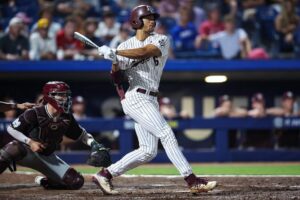Sox Draft Philosophy Focused On Long-Term Results, Not Top 100 Prospects
It’s a fool’s errand to judge draft classes in any sport in the immediacy in which many of us do so.
In baseball, it’s especially tough to grasp. The White Sox have one of the deepest farm systems in the sport and publications have painted a rosy picture to even the most casual of baseball fans this week. Here at FutureSox, our top 30 list of organizational prospects was published last week. Baseball America and Baseball Prospectus unveiled their list of the top 100 players in the minor leagues. Over the weekend, mlbpipeline.com dropped their list and held a television special to go with it. The crew at Fangraphs and Keith Law of ESPN will be dropping their versions soon as well.
Accumulating enough talent to ultimately contend for championships annually is more important than having players littered all over prospect lists. Being well represented on prospect lists is often an indicator of future success, however. Outfielders Eloy Jimenez and Luis Robert, infielder Nick Madrigal and pitchers Michael Kopech and Dylan Cease are generally placed along with the top 50 prospects in the sport. Jimenez is in the top 5 for every publication. Cease, Kopech and Robert are usually in the top 45. Madrigal is even as high as #15 on the list at Baseball Prospectus. Right-hander Dane Dunning is listed for multiple publications as well. There’s also a chance that catcher Zack Collins could be listed at Fangraphs and outfielder Micker Adolfo is a contender for Law’s list at ESPN.

Luis Robert with the Winston-Salem Dash, 2018 (Clinton Cole / FutureSox)
These lists don’t lack White Sox prospects and because of that, the organization has a farm system that is generally regarded as one of the five best in baseball. One thing that the lists do lack though are players drafted by the White Sox. There are many ways to skin a cat and the organization has been adept at acquiring talent through trades and by using international free agency but they must bear fruit with their homegrown selections. Jimenez, Kopech, Cease, and Dunning were all acquired through trades. Robert and Adolfo were signed as international free agents. Madrigal was the lone draft pick listed on any publication’s top 100 list and he was the most recent selection by the club.
Under the leadership of Nick Hostetler, drafts have been heavily predicated on college talent. Hostetler took over as Director of Amateur Scouting after the 2015 season and was even responsible for the draft picks after the first round in that class. Without 2nd or 3rd rounders in that year, the front office still nabbed RHP Jordan Stephens (5th round), 1B Corey Zangari (6th round) and C Seby Zavala (12th round). Stephens and Zavala should make their major league debuts at some point in 2019. In 2016, the White Sox selected Zack Collins from the University of Miami, Zack Burdi from Louisville and Alec Hansen from the University of Oklahoma. Hostetler followed up that class by going back to the college as well in 2017 with Jake Burger at #11 overall out of Missouri State and Gavin Sheets in round 2 out of Wake Forest. Madrigal was the 4th overall pick in 2018 out of Oregon State and the club doubled up by selecting outfielder Steele Walker from Oklahoma.

Catcher Seby Zavala with the Knights in 2018 (Clinton Cole / FutureSox)
It’s impossible to judge the value of a draft class this soon but many fans questioned whether the lack of drafted prospects occupying these lists from over the years was an indictment on the organization. It’s especially telling when there are players littered throughout these lists who were conceivably available to the White Sox as well. Many of these players are of the high school variety and that just hasn’t been an organizational emphasis of late in the early rounds. Under the current leadership and scouting department, the club hasn’t drafted a prep player in the first three rounds. Due to a small sample size, it’s yet to be determined if those outcomes are more of a general philosophy, an organizational emphasis or otherwise. It would behoove the franchise going forward to change that premise if it is indeed a favored plan.
Hostetler has a long history of scouting amateur talent and he’s discussed his predilection for prep talent in the past as he got his start doing just that in Atlanta with the Braves. The White Sox’s organization has typically favored college talent to high school talent and they have preached the philosophy of selecting the “best player available”. Whether the best player decree is just a guise to lean on college standouts is left for interpretation due to the subjective nature of drafts in general. The people following along at home have no idea whether clubs actually mean it or not, and it isn’t black and white either. They can only be judged on results and some of that is happening now as premature as it ultimately may be. What the results show is that as good as the Sox system is perceived to be, the lack of drafted talent taking up space on top 100 lists is alarming. College prospects are theoretically closer to the major leagues, safer bets to produce and generally have higher floors as prospects. They also have much less margin for error though and some of those shortcomings have affected the organization recently.
Nick Madrigal is 21-years-old and is slated to be the second baseman in Winston-Salem to start the year. The 22-year-old Steele Walker likely begins his season in High-A as well. Zack Collins will be 24 when the season starts and he’ll be making his season debut in Charlotte after years of developing on the defensive side. Zack Burdi will be pitching in Charlotte as a 24-year-old as well after recovering from Tommy John Surgery last year. Big righty Alec Hansen, also 24, is a bit of a wildcard after struggling mightily with his command last year and being demoted back down to High-A. Gavin Sheets will likely be the primary first baseman in Birmingham as a 23-year-old after receiving a $2 million bonus as a 2nd rounder in 2017 and while many in the organization are optimistic about his future, the power potential must start to play regularly outside of batting practice.

OF Steel Walker, Intimidators, 2018 (Clinton Cole / FutureSox)
That leads the discussion to the unfortunate reality of Jake Burger. The former Missouri State star was selected with the 11th pick in the 2017 draft and was seen as a fast-moving college hitter. Burger is recovering from surgery to repair a twice-ruptured Achilles tendon and should be ready for baseball action at some point in June. These weren’t poor selections. It’s too early to make that sort of determination. These instances are evidence though that leaning heavily on the college route isn’t necessarily devoid of risk. Players who develop at a slower pace or incur a setback of any variety don’t have youth on their side in the same fashion that a high school prospect would. Luckily for the Chicago White Sox though, landing players on top prospect lists at various publications isn’t the organizational goal of the draft. It is to supply the organization with enough premium talent to compile a critical mass that will be used as currency in addition to filling holes in Chicago.
Silver Linings
While there is some apparently limited upside, the farm system as a whole is regarded highly in the baseball industry. On our preseason top 30 list here at FutureSox, 20 of the 30 players listed were drafted by the organization. That is a positive development for the franchise. There are some day three selections with some serious upside in the system and that’s not something that is common amongst clubs. Pitcher Ian Hamilton (11th), infielders Bryce Bush (33rd) and Laz Rivera (28th) along with catcher Seby Zavala (12th) are players that could help the team in some capacity down the road. Pitchers such as Tyler Johnson, Jimmy Lambert, Bernardo Flores, Konnor Pilkington and Jonathan Stiever have considerable upside and offer some promise as former drafted players as well. Luis Gonzalez was drafted out of New Mexico in 2017 and posted a 146 wRC+ with a .397 wOBA in High-A last season while hitting 14 homers. 2016 3rd rounder Alex Call was used in a trade this off-season.
Many evaluators believe that Nick Madrigal will be a future star. He should spend the majority of 2019 in Birmingham and could be on a fast track to the majors if things go accordingly. Zack Collins has never posted a wRC+ of less than 128 as a pro and will be playing his home games in hitter-friendly Charlotte. He should see the big leagues in 2019. Zack Burdi is recovered from Tommy John surgery and will be eased back into action in Triple-A and should see Chicago at some point this summer. He’s still the highest upside reliever in the system. Alec Hansen could realistically get back on track and move quickly to the majors in some capacity.
Burger has to make up for lost time but the injury wasn’t a death sentence. He has 80-grade makeup and I wouldn’t bet against him personally. Sheets needs to hit for power in games but the White Sox don’t seem to be worried about that. He is a good defender at first base and posted a 123 wRC+ in Winston-Salem. Sheets could be in Chicago by mid-season 2020 if he produces power in games. Walker had a rough showing to end last year but his energy and talent level could push him to the fringes of a top 100 list in the near future.
Many of these players could play a part in winning clubs in Chicago in the near future. Some of them could also be used as currency to acquire other players that could help in the future. While some of these college draft picks lack the upside of many of the prep players taken after them, most of them appear to be big leaguers. The White Sox needed to insulate their farm system with baseball players. The floor has been created. Nick Hostetler has only been in charge of three drafts and development doesn’t end once the rebuild does. The strategy this year and in future years will be picked at with a fine-toothed comb because some trends have been set. The White Sox have a chance to change the narrative but nobody will care about this one if the big league club ends up competing annually. Many of these players will be tasked with that job and they were drafted because the organization feels they’ll be ready to do so when that time comes.
Want to know right away when we publish a new article? Type your email address in the box on the right-side bar (or at the bottom, if on a mobile device) and click the “create subscription” button. Our list is completely spam free, and you can opt out at any time.






